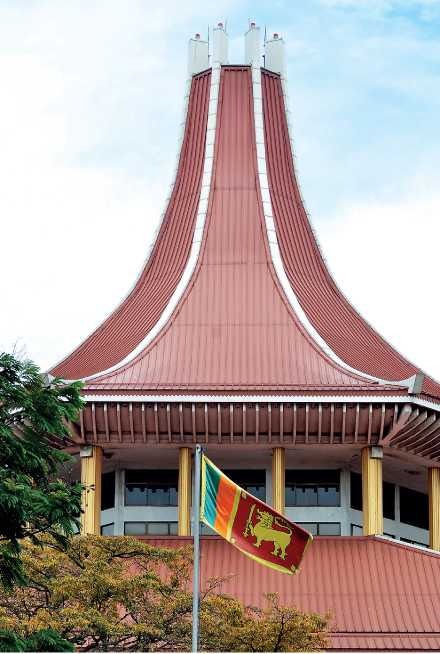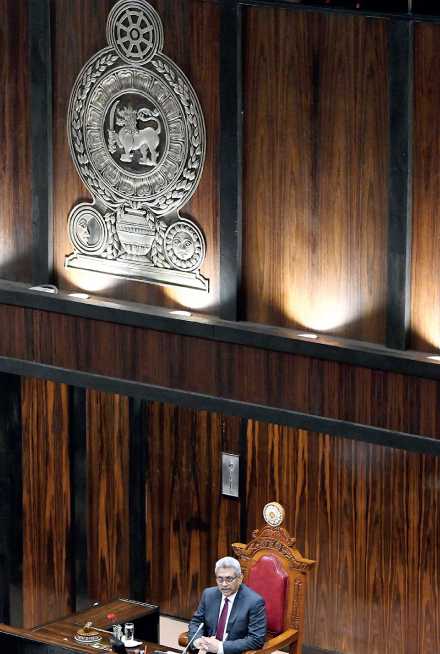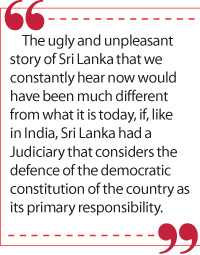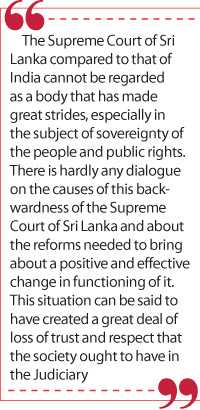Wednesday Apr 02, 2025
Wednesday Apr 02, 2025
Friday, 16 October 2020 01:17 - - {{hitsCtrl.values.hits}}

The role played by the Supreme Court of India in protecting and modernising democracy in India is immense. Regrettably the Supreme Court of Sri Lanka has not played such a major role in this regard

Most of the things that the President intends removing from the Constitution through the 20th Amendment can be described as instruments of the sovereignty of the people
The people are the real owners of sovereignty both in terms of the classical liberal opinion and the domestic and international law. In other words, State power lies with society and the rulers elected by the people are subject to the will and the control of the people. In this context, the 20th Amendment can be considered a constitutional adjustment that undermines and lets down the sovereignty of the people. 
Most of the things that the President intends removing from the Constitution through the 20th Amendment can be described as instruments of the sovereignty of the people. A Court decision that gives approval and provides guidance for legislation of such constitutional amendments cannot be considered a correct or sound judgment of the Judiciary.
Judiciary of Sri Lanka
The ugly and unpleasant story of Sri Lanka that we constantly hear now would have been much different from what it is today, if, like in India, Sri Lanka had a Judiciary that considers the defence of the democratic constitution of the country as its primary responsibility.
If it had been so, a significant number of Indian plantation workers who were entitled to citizenship might have received citizenship rights under the Citizenship Ordinances of 1948 and 1949. Similarly, the Official Languages Act of 1956 might have been enacted in such a way that the Tamil people would not be deprived of their right to have reasonable use of their language.
If the Judiciary of Sri Lanka had possessed a far-reaching vision, it would certainly have prevented the deprivation of itself of the power of judicial review on the functioning of the Legislature and the Executive and ensured the independence of Civil Service despite approving the enactment of the 1972 Constitution which primarily aimed at severing the binding obligations of the country to the British crown.
Had there been a Judiciary of that calibre in Sri Lanka , President Jayewardene would not have been allowed to play with the Constitution, the way he had done, using the 5/6 majority that he commanded in Parliament. The term of Parliament which had been approaching the point of expiry in any way, could not have been possible to be extended by a contemptible referendum.
Similarly, President Chandrika would not have been able, with the connivance of the Judiciary, to adopt a method that enabled opposition MPs to join the government without losing their parliamentary seat. Also, it wouldn’t have been possible for the 17th, 18th, 19th or 20th Amendments to be enacted the way they had been enacted. If that were the case, Sri Lanka wouldn’t have ended up being a blood shedding country on a large scale; instead it would have become a rich and developed country, rather than ending up being the impoverished and bankrupt country which it is today.
The role played by the Supreme Court of India in protecting and modernising democracy in India is immense. Regrettably the Supreme Court of Sri Lanka has not played such a major role in this regard. Instead, it can be seen that the Supreme Court of Sri Lanka has followed a policy that encouraged and supported the rulers in some instances when they have violated the Constitution.
 The Judiciary of India
The Judiciary of India
The Supreme Court of India can be considered as the highest institution created by a highly-advanced Constituent Assembly formed in the course of protracted struggle for independence. The Constituent Assembly conferred all the powers required to maintain an independent Judiciary including the power of Judicial Review to the Supreme Court of India. The confidence placed on Judiciary by the Constituent Assembly was so great that the Judiciary regarded it as a mandate given to it to be the defender and custodian of the Indian social revolution unleashed by the freedom struggle.
It can be said that the Supreme Court of India has been able to maintain the maximum trust placed in it by the Constituent Assembly. For instance, when Indira Gandhi, one of the most powerful rulers of India attempted to violate the Constitution, the Judiciary went to great lengths in opposing her actions rather than pursuing a policy that supported her act.
Since then, India has adopted a principle on basic structure of the Constitution to prevent Indian politicians from changing the Constitution for narrow political gains and insidious purposes, thereby depriving the Indian rulers of the opportunity to play with the Constitution.
However, the Supreme Court of India does not deny the fact that the Legislature has the power to change the Constitution. But the interpretation of this new Law passed on the Constitution can be considered to have established an abiding principle that there will be no room for changes that could cause damage to the basic structure of the Constitution itself. Accordingly, certain basic features of the Constitution cannot be altered or destroyed through amendments by the Parliament of India.
The Supreme Court of Sri Lanka
The Supreme Court of Sri Lanka compared to that of India cannot be regarded as a body that has made great strides, especially in the subject of sovereignty of the people and public rights.
There is hardly any dialogue on the causes of this backwardness of the Supreme Court of Sri Lanka and about the reforms needed to bring about a positive and effective change in functioning of it. This situation can be said to have created a great deal of loss of trust and respect that the society ought to have in the Judiciary.
Although the Donoughmore Constitution has vested the power of judicial review in the Supreme Court, the latter however did not exercise it to prevent the enactment of Citizenship Ordinances which were introduced in violation of the Constitution or to avert injustices caused by the enactment of the Sinhala Official Languages Act. Instead, what it had done was to gang up with the ruling party and pursue a policy of collaborating with the latter allowing the violations to become established.
The First Republican Constitution of 1972 completely abolished the power of review of the Judiciary, and the Second Republican Constitution of 1978 curtailed it and kept it within a limited frame. Not only did this situation not provoke strong opposition from the Judiciary, but also the Supreme Court did not show any interest in securing the power of judicial review to itself.
Judicial review is the power of the Judiciary to examine any Act of Parliament or Law and to determine whether they are consistent with the constitution and to rescind any Act or Law if it is not in conformity with the Constitution. A Judiciary without this power cannot be reckoned to be an independent Judiciary. However, the Judiciary of Sri Lanka can be considered as one that has largely lost its jurisdiction on the judicial review of the acts of the Legislature and the Executive. If the 19th Amendment could be considered a major turning point in the field of democracy, it was by that this error should have been rectified, but it did not happen.
 The decline of the Supreme Court
The decline of the Supreme Court
There has never been an era like that of the regime of President Jayewardene in which the Judiciary was unduly interfered with. Yet, it can also be considered as an era in which the Supreme Court of Sri Lanka has shown a remarkable revival and progress.
Chief Justice Neville Samarakoon is worthy of most of the honour that it deserves. He happened to be a personal friend of President Jayewardene, but he subordinated his friendship with the President from the moment he was appointed the Chief Justice and assumed the role of a true Chief Justice. In the end, even the President, who commanded a five-sixths majority in Parliament, could not make him dance to his tune as he wished. Chief Justice Neville Samarakoon was able to safeguard and maintain the sanctity and the proud image of the Supreme Court.
Even after the term of Neville Samarakoon as CJ was over, the brightness of the lamp he lit in the Supreme Court did not douse. His successors continued the progress that the Supreme Court had achieved under the leadership of Neville Samarakoon. It was Sarath Nanda Silva, who became the Chief Justice in 1999, who can be described as the one who destroyed the progress and the good image of the Supreme Court and turned everything upside down.
My conflict with Sarath Nanda Silva can be described as a long process of events that originated and evolved by an accidental event. I was compelled to look into details of two ugly incidents involving a Magistrate of a Lower Court who had influenced two women, who were the respondents of two cases heard by him, to gratify his sexual desires. Sarath Silva was the Attorney General at that time.
Of the two women who were sexually misused by the Magistrate, the incident pertaining to the first one had been investigated by the CID and the report forwarded to the Department of Attorney General for further advice. Despite the fact that the report contained adequate information which was sufficed to prove that the Magistrate concerned was a person with a despicable history of fraud and acts of misconduct, the Attorney General adopted a policy of protecting the corrupt Magistrate who is not fit to be allowed even to step into the premise of the Judiciary, let alone being employed as a Magistrate. Under the circumstances, I was compelled to investigate into the conduct of the Attorney General also and to make a noise on the ugly things perpetrated by him contrary to the law.
At that time not only the Judiciary but also the Bar Association were not in a backward state as they are today; they were seriously concerned in rectifying internal defects and correcting themselves. In this case, I raised my voice against a Magistrate (Lenin Ratnayake), a District Judge (Upali Abeyratne) and the Attorney General. While I continued the protest against this injustice, Romesh de Silva, the then Head of the Bar Association, convened a conference of former presidents of the Bar Association to decide on what to do about my questioning of the Judiciary.
The conference was of the view that the allegations made by me against the two judges should be investigated, and if they were found to be unfounded, the Judiciary should take stern action against me, and if the allegations against them were substantiated, the allegations made against the Attorney General also should be investigated.
Accordingly, two tripartite investigating committees consisting of the judges of the Court of Appeal were appointed to look into the allegations against the two judges, and both of them were found guilty by the two committees. Thereafter, along with Jayasekara, the Chemical Engineer a complaint was lodged by me with the Supreme Court against Sarath Nanda Silva, the Attorney General. The Supreme Court initiated an inquiry against the Attorney General based on those two complaints.
Judiciary turned upside down
It was at this juncture that G. P. De Silva retired from the post of Chief Justice. What President Chandrika did was to appoint Sarath Nanda Silva, the Attorney General, and her friend who was in a state of complete strangulation, to the post of Chief Justice ignoring the allegations against him, and saving him from the predicament he was facing. There was a strong protest against this unethical appointment both locally and internationally. But the fault was not rectified. Since then the new Chief Justice turned the Judiciary upside down and made it a place where corruption was rampant.
Although the UNP Government that came to power following the Parliamentary Election of December 2001 had the ability to remove this horrendous cancer that had plagued the Judiciary, Prime Minister Ranil Wickremesinghe did not want to take any action to tackle the issue.
I did everything I could and within my capacity against the appointment of Sarath Nanda Silva who had been accused of gross misconduct, as the Chief Justice. The Ravaya newspaper published the picture of him swearing up before the President, upside down as a black issue under the caption ‘the demise of the Judiciary ‘. Apart from that I filed a case against his appointment in the Supreme Court, which was under his jurisdiction.
The owners of media institutions made use of this opportunity to assist the Chief Justice in that difficult moment and they were able to have their serious lawsuits lying before the court, settled to their advantage, with his blessings. Even the political parties which appeared as alternate progressive movements, such as the Janatha Vimukthi Peramuna (JVP) and the Jathika Hela Urumaya (JHU), adopted a policy of defending the corrupt Chief Justice with the view to obtaining favourable judgments on cases against them that would enhance the reputation of their parties.
The media institutions of the country also followed a policy of protecting the corrupt Chief Justice to the maximum. So much so, all of them have negated the great opportunity offered by this historic moment to reform the Judiciary, thus letting the state of serious deterioration set in the Judiciary to solidify. The compensation that has to be paid for this squalid deed now, not only by all those who have contributed to it, but also by the country in general, is huge.
Pix by Shehan Gunasekara